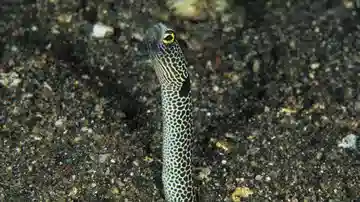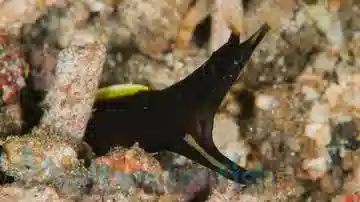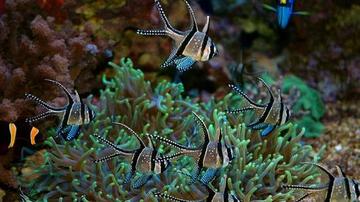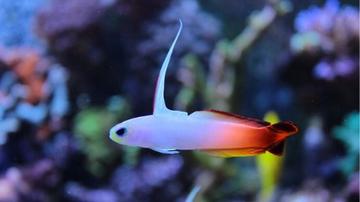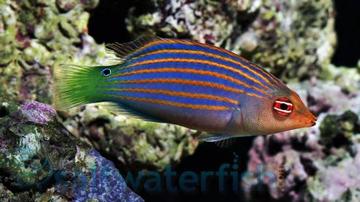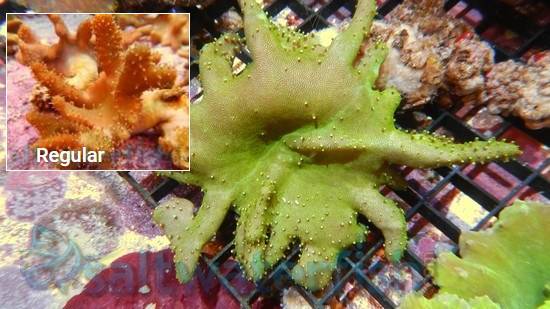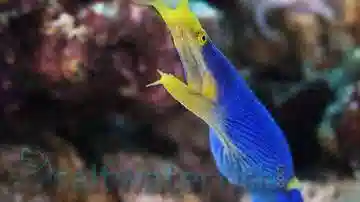Expert Only
Blue Ribbon Eel
Rhinomuraena quaesita
(1 Reviews)
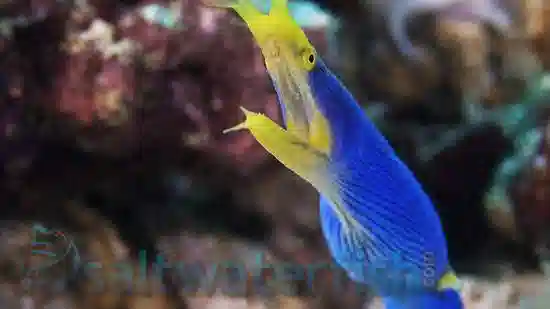
Expert Only
Blue Ribbon Eel
Rhinomuraena quaesita
(1 Reviews)
{{ item.name }}
Size: {{ item.extra_field_3 }}
${{ getFormattedPrice(item.saleprice) }} ${{ getFormattedPrice(item.price) }}
To join the waiting list, click here
Free Shipping
With
$199.00
or more in Marine Life.
More details...
Blue Ribbon Eel Care Facts
| Care Level: | Expert |
|---|---|
| Temperament: | Aggressive |
| Diet: | Carnivore |
| Reef Safe: | No |
| Minimum Tank Size: | 120 gallons |
| Max Size: | 50 inches |
The Black Ribbon Eel, Rhinomuraena quaesita, also goes by the names of the Blue or Yellow Ribbon Eel. These Eels are quite unique, they are black and yellow and resemble a ribbon, hence the name. Unlike the more common Snowflake Eel, the Blue Ribbon Eel is much more slim and has a very unique face. They can reach a maximum length of 40", which is not very large in Eel terms. Eels are known to try to escape from the aquarium and can be challenged to keep, that is why we recommend a tank with a tightly sealed lid. These Eels will only eat when they are comfortable with their surroundings and have a cave large enough for their long bodies to completely fit into. PVC pipes make great tunnels and you can get very creative with them. The Eel is not guaranteed to accept PVC as a home, so it is suggested to have plenty of caves and rockwork in the tank for easier acclimation. It is important to watch your hands if you are hand feeding the Eel as they can bite. Feeding tongs can be useful, and are highly suggested when feeding your Eel. Since they are predatory, and their eyesight is not great, they may mistake your hand for food. They are also ambush predators, and should not be housed with any fish small enough to fit into it's mouth. The Blue Ribbon Eel is a very finicky eater, and can be difficult to get to start eating in the beginning. They also require pristine water, therefor your water quality should be perfect. No ammonia, nitrates, nitrites, and a pH of around 8.3 will ensure a healthy Eel. Keep your temperatures between 72-78?� F and dKH between 8 and 12. That is why we suggest only experts care for this marine life.
They can be prone to bothering small sessile inverts and small fish so are considered reef safe with caution. They will feed on a carnivorous diet that can consist of small feeder Fish, such as Mollies, and live inverts, such as Shrimp, Krill, Crabs along with a diet of various meaty preparations enriched with vitamins.
Blue Ribbon Eel (Rhinomuraena quaesita) - A Comprehensive Guide for Saltwater Marine Aquariums
This guide provides essential information for saltwater marine aquarium enthusiasts looking to care for the captivating and unique Blue Ribbon Eel (Rhinomuraena quaesita). We'll explore their natural habitat, reef compatibility, size, lifespan, dietary requirements in captivity, aquaculture availability, sexual dimorphism, symbiotic relationships, juvenile versus adult coloration, temperament, tank specifications, and precise water conditions. By following this guide, both novice and experienced aquarists can ensure the well-being of their Blue Ribbon Eel in a home aquarium.
Habitat of the Blue Ribbon Eel (Rhinomuraena quaesita):
The Blue Ribbon Eel is found in the Indo-Pacific region, dwelling in a range of habitats from lagoons to outer reef slopes. They prefer areas with sandy substrates, crevices, and burrows where they can hide. These eels are renowned for their remarkable appearance, with long, ribbon-like bodies and vibrant blue coloration.
Reef Safe Nature of Blue Ribbon Eels:
Blue Ribbon Eels are generally not considered reef-safe, making them suitable for reef aquariums. Their burrowing behavior and peaceful disposition often make them compatible with various coral and invertebrate species. However, providing them with an appropriate diet is crucial to discourage any potential interest in smaller tank mates.
Size of Blue Ribbon Eels:
Blue Ribbon Eels can reach impressive lengths of up to 39 inches (1 meter) when fully grown. Considering their potential size is essential when planning your aquarium setup.
Lifespan of Blue Ribbon Eels:
With proper care, Blue Ribbon Eels can live relatively long in captivity, often ranging from 10 to 20 years. This longevity makes them a rewarding addition to marine aquariums for dedicated aquarists.
Diet in Captivity:
Blue Ribbon Eels are carnivorous and feed on small fish and crustaceans in their natural habitat. In captivity, replicating their diet can be challenging, but ensuring their health and longevity is crucial. Suitable foods include:
- High-quality marine-based frozen foods such as krill, shrimp, and silversides.
- Live or frozen small fish and crustaceans.
- Offer food items using long feeding tongs to avoid potential accidental bites during feeding.
- Feeding Blue Ribbon Eels two to three times weekly is typically sufficient to meet their dietary needs.
Aquaculture Availability:
Unfortunately, Blue Ribbon Eels are unavailable through aquaculture efforts, and most specimens in the aquarium trade are still wild-caught. To support ethical and sustainable practices, it's essential to purchase Blue Ribbon Eels from reputable suppliers who prioritize the well-being of the eels and the protection of their natural habitats.
Sexual Dimorphism:
Blue Ribbon Eels do not exhibit significant sexual dimorphism, and distinguishing between males and females based on physical characteristics can be challenging.
Symbiotic Relationships:
Blue Ribbon Eels often form symbiotic relationships with cleaner shrimp in the wild. Cleaner shrimp help maintain the eels' hygiene by removing parasites and dead skin. However, introducing cleaner shrimp to a home aquarium can be tricky, as they may become prey if not carefully chosen and acclimated.
Juvenile vs. Adult Coloration:
Juvenile Blue Ribbon Eels are predominantly jet black. As they mature into adults, they transform remarkably, changing their color to a striking electric blue, which earned them their common name.
Compatibility:
When considering a Blue Ribbon Eel for your saltwater aquarium, compatibility with other tank inhabitants is essential for maintaining a thriving ecosystem.
Temperament of Blue Ribbon Eels:
Blue Ribbon Eels are generally peaceful and solitary creatures but can become territorial, especially when introduced into a tank with limited space or other eels. Providing them with a suitable environment and tank mates is crucial to minimize stress and aggression.
Suitable Tank Mates:
Here are five compatible tank mates that can potentially coexist peacefully with Blue Ribbon Eels:
- Hawkfish (Cirrhitidae): Hawkfish are generally peaceful and can thrive alongside Blue Ribbon Eels if they have enough swimming space.
- Large Angelfish (Pomacanthidae): Some larger angelfish species, like the Emperor Angelfish (Pomacanthus imperator), can be suitable tank mates if adequately acclimated and introduced.
- Lionfish (Pterois spp.): Lionfish are typically slow-moving and can coexist with Blue Ribbon Eels if they are not overly aggressive.
- Triggerfish (Balistidae): Certain triggerfish species, like the Picasso Triggerfish (Rhinecanthus aculeatus), can be compatible if the tank size permits.
- Tangs (Acanthuridae): Larger tang species may work well as tank mates but ensure enough space and hiding spots to reduce territorial behavior.
Tank Requirements:
Creating an ideal environment is crucial for the well-being of Blue Ribbon Eels. Here are some essential tank requirements:
- Minimum Tank Size: A tank with a capacity of at least 120 gallons is recommended to provide ample space for swimming and burrowing.
- Substrate: A fine, sandy substrate allows the eel to burrow comfortably.
- Aquascaping: Provide plenty of hiding spots, such as PVC pipes or rock formations with crevices. Ensure secure lids or covers, as Blue Ribbon Eels are known to be escape artists.
- Water Conditions: Maintain stable water conditions within the following parameters:
- pH: Keep the pH level between 8.1 and 8.4.
- Salinity: Maintain a salinity level between 1.024 and 1.026.
- Water Temperature: Keep the water temperature in the range of 74°F to 78°F (23°C to 26°C).
- Water Flow: Provide moderate water flow, as excessive flow can stress the eel.
Other Common Names:
The Blue Ribbon Eel is also known as the Ribbon Eel or Black Ribbon Eel.
Why People Should Buy the Blue Ribbon Eel from Saltwaterfish.com:
Purchasing Blue Ribbon Eels from reputable suppliers like Saltwaterfish.com ensures the highest the highest quality and ethical sourcing. These suppliers prioritize the well-being of the eels and the protection of their natural habitats through sustainable practices. By choosing a reputable source, aquarists can contribute to the conservation of these remarkable creatures and enjoy the privilege of observing their unique beauty in their home aquariums.
In conclusion, with its stunning appearance and captivating behavior, the Blue Ribbon Eel is a remarkable addition to saltwater marine aquariums. Careful consideration of their habitat, tank mates, and feeding requirements is essential to ensure their health and well-being in captivity. By following this guide and sourcing eels from ethical suppliers, aquarists can enjoy the presence of this mesmerizing creature while contributing to marine conservation efforts.Expert Only: Items designated as expert only require special care such as a species specific environment, special diet or care, and an expert level, experienced aquarist. Not for beginners. Expert Only items qualify for our live arrival guarantee only, and are exempt from our extended 8 day guarantee.
Very good Blue Ribbon Eel for your tank. I have lost this species and don't know why. Purchased a new one which just arrived.
Reviewed by: Brian Dogith on Sept. 12, 2021


